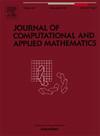健康人发声驱动的流固声相互作用的数值模拟
IF 2.6
2区 数学
Q1 MATHEMATICS, APPLIED
Journal of Computational and Applied Mathematics
Pub Date : 2025-05-28
DOI:10.1016/j.cam.2025.116771
引用次数: 0
摘要
本文提出了流固声相互作用(FSAI)问题的数学模型,并重点介绍了健康人发声的数值模拟。数学模型包括弹性体变形、流体流动、声学及其耦合条件。特别注意了声带接触带来的挑战,这在模型中通过入口惩罚边界条件和虚拟多孔介质的引入来解决。数值模型基于稳定有限元法,在内部求解器中实现。给出了考虑对称声带振动的数值结果,重点分析了惩罚参数和间隙阈值对对称声带振动的影响。最后,利用Lighthill类比法和气动声波方程方法,对声道模型中代表元音[u:]的声道进行气动声学模拟。本文章由计算机程序翻译,如有差异,请以英文原文为准。
Numerical simulation of fluid–structure–acoustic interaction motivated by healthy human phonation
This paper presents the mathematical model for fluid–structure–acoustic interaction (FSAI) problems with a particular focus on numerical simulations of healthy human phonation. The mathematical model consists of elastic body deformation, fluid flow, acoustics and their coupling conditions. A special attention is paid to challenges posed by the vocal folds contact, which is addressed in the model by the inlet penalization boundary conditions and an introduction of fictitious porous media.
The numerical model is based on the stabilized finite element method, implemented in an in-house solver. Numerical results are presented for the considered symmetric vocal fold vibrations, for which particularly the influence of penalization parameter and gap threshold is analyzed. Finally, the aeroacoustic simulations in the vocal tract model representing the vowel [u:] are performed with the help of the Lighthill analogy and the aeroacoustic wave equation approach.
求助全文
通过发布文献求助,成功后即可免费获取论文全文。
去求助
来源期刊
CiteScore
5.40
自引率
4.20%
发文量
437
审稿时长
3.0 months
期刊介绍:
The Journal of Computational and Applied Mathematics publishes original papers of high scientific value in all areas of computational and applied mathematics. The main interest of the Journal is in papers that describe and analyze new computational techniques for solving scientific or engineering problems. Also the improved analysis, including the effectiveness and applicability, of existing methods and algorithms is of importance. The computational efficiency (e.g. the convergence, stability, accuracy, ...) should be proved and illustrated by nontrivial numerical examples. Papers describing only variants of existing methods, without adding significant new computational properties are not of interest.
The audience consists of: applied mathematicians, numerical analysts, computational scientists and engineers.

 求助内容:
求助内容: 应助结果提醒方式:
应助结果提醒方式:


